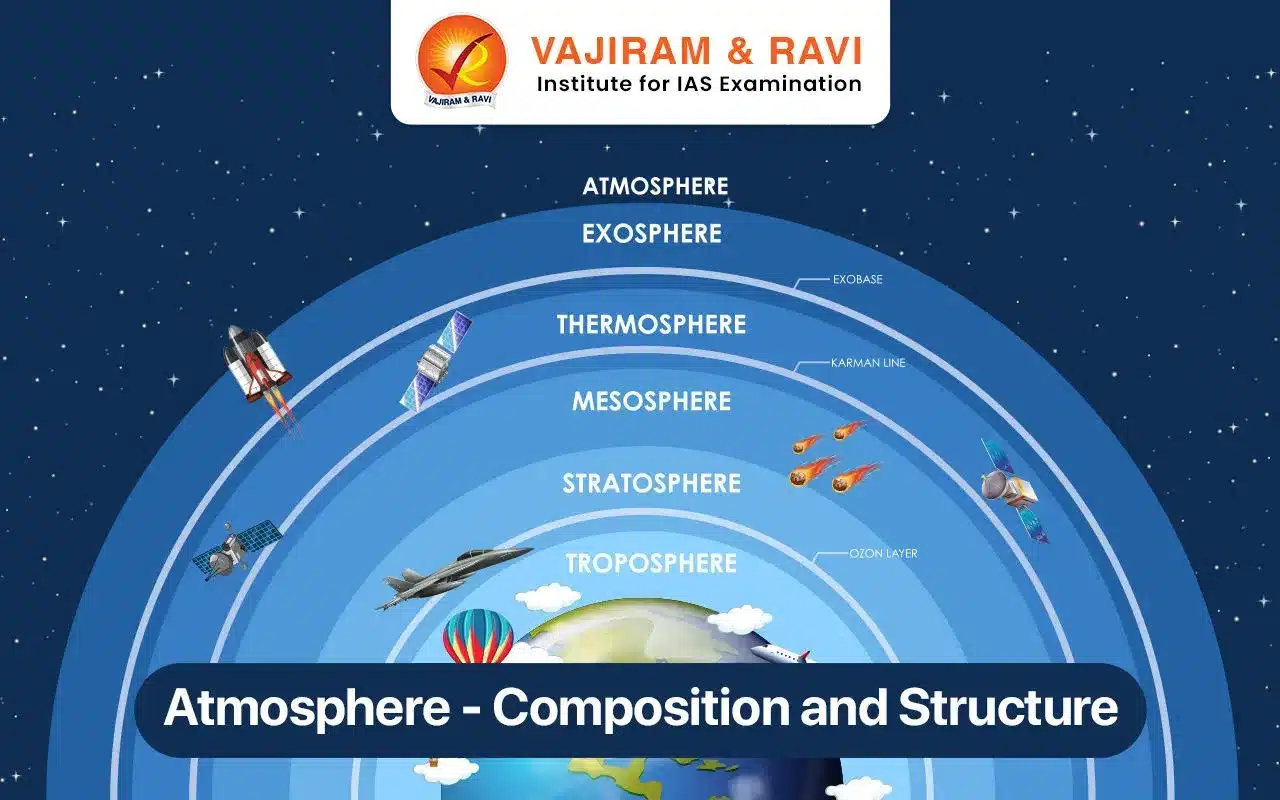The atmosphere is the layer of gases surrounding Earth. The air is an essential component of the earth’s mass, and 99 percent of the total mass of the atmosphere is concentrated at a height of 32 kilometres above the earth’s surface, held in place by gravity. Nitrogen and oxygen account for 99 percent of the gases in dry air, with argon, carbon dioxide, helium, neon, and other gases making up the remaining volume. The combination of gases in the atmosphere forms a complex system divided into layers that support life on Earth.
The atmosphere can be divided into five layers – Troposphere, Ionosphere, Stratosphere, Exosphere, and Mesosphere. These atmospheric layers are characterised by variations in temperature resulting primarily from the absorption of solar radiation.
Atmosphere Composition
Earth’s atmosphere comprises about 78 percent nitrogen, 21 percent oxygen, 0.9 percent argon, and 0.1 percent other gases. The remaining 0.1% of gases includes a trace amount of neon, water vapour, carbon dioxide, methane and others. Water vapour and Carbon dioxide are found up to 90 km from the earth’s surface.
- Nitrogen: Nitrogen is the most prevalent element in the atmosphere’s dry composition. At the Earth’s surface, nitrogen slows down the rate of burning and dilutes oxygen. Living things require nitrogen to synthesise proteins.
- Oxygen: It is essential for respiration and necessary for combustion (burning).
- Carbon dioxide:
- It is essential for photosynthesis by plants, algae and photosynthetic bacteria, to be used by living things as food.
- It acts as a blanket that prevents heat from escaping into space called the greenhouse effect. It absorbs some of the terrestrial radiation and reflects some of it toward the surface of the earth.
- Ozone: It serves as a filter and can be found between 10 and 50 kilometres above the surface of the earth which absorbs harmful ultraviolet rays from the sun and stops them from reaching the earth’s surface.
- Water Vapour: It is typically present in up to 4% of the total volume, depending on location. With an increase in altitude, water vapour levels decline.
- When dry winds blow through the Earth’s desert regions (30° N/S), the contribution of water vapour to the composition of the atmosphere is nearly zero.
- Dust Particles: In the lower layers of the atmosphere, dust particles are typically concentrated, but convectional air currents can carry them to great heights.
- They are more concentrated in subtropical and temperate regions than in equatorial and polar regions due to dry winds.
Atmosphere Structure
The atmosphere is divided into five layers, depending on temperature and density. In general, both temperature and density decrease with increasing altitude.
| Layers of the Atmosphere | |
| Troposphere | – The troposphere is the lowest layer and its average height is 13 km and extends roughly to a height of 8 km near the poles and about 18 km at the equator.
– It is thickest at the equator because heat is transported to great heights by strong convection currents and much thinner at the North and South Poles. – Approximately 75 and 80 percent of the mass of the entire atmosphere is contained in the troposphere. – Most of the water vapour in the atmosphere, along with dust and ash particles, are found in the troposphere that’s why most of Earth’s clouds are located in this layer. – Temperatures in the troposphere decrease with altitude. Tropopause: The zone separating the troposphere from the stratosphere is known as the tropopause.
|
| Stratosphere | – The stratosphere rises to a height of 50 km, above the tropopause.
– It contains the ozone layer which absorbs ultravioletradiation and shields life on the earth from intense, harmful forms of energy. – Temperature in the stratosphere increases with altitude as a result of heat that is produced during the formation of ozone. – There is almost no water vapour in the stratosphere. – Although the stratosphere is nearly cloudy and weather-free, polar stratospheric clouds can occasionally be found at its lowest, coldest altitudes. – It’s the highest point in the atmosphere that jet planes can access. – The top of the stratosphere is called the stratopause. |
| Mesosphere | – It is located between 50 and 80 kilometres above the surface of the Earth.
– The temperature in the stratosphere decreases with altitude. – With a temperature of about -90°C, the top of this layer is the coldest place on Earth. – Noctilucent clouds (night-shining clouds) or polar mesospheric clouds are formed by the extremely rare water vapour that is found at the top of the mesosphere. – Meteors typically burn up in this layer of the atmosphere. – Both Sounding rockets and rocket-powered aircraft are capable of reaching the mesosphere. – The upper boundary of the mesosphere is called the mesopause. |
| Thermosphere | – The Thermosphere is located between about 80 and 700 kilometres above Earth’s surface
– The ionosphere (between 80 and 400 km) is a part of it.
– The Thermosphere is both cloud and water-vapour-free. – Here, one can occasionally see the aurora australis and borealis. – The International Space Station orbits in the thermosphere. |
| Exosphere | – The topmost layer of Earth’s atmosphere is known as the exosphere.
– Located between about 700 and 10,000 kilometres above the surface of the Earth. – Because the molecules in this layer have a very low density, this layer does not behave like gases and allows particles to escape into space. – The bottom of the exosphere is also known as the exobase. |
Weather
Weather is a combination of events that occur in our atmosphere daily. The weather varies around the world and changes over a few minutes, hours, days, and weeks. The troposphere, the region of Earth’s atmosphere closest to the ground, is where most weather happens.
- Air Pressure and Weather: Changes in atmospheric pressure determine the weather that occurs in a region.
- Usually, clear, blue skies are present when air pressure is high. The high pressure prevents clouds from forming by causing air to flow down and fan out when it gets close to the ground.
- Low air pressure causes air to flow together before converging upward, where it rises, cools, and forms clouds.
Climate
Climate refers to an area’s average weather pattern over a long period. The weather is what we see outside on any particular day; the climate is the average of that weather. Different regions have different regional climates.
- Global climate: The average of all regional climates is referred to as the global climate. Weather patterns are anticipated to change along with the global climate.
- Elements of Climate: The main elements of climate are temperature, pressure, winds, and rainfall. All these elements are highly variable and constitute the climate.
- They are inextricably linked, and any change in one of them usually causes changes in the others.
- The variations in climate are largely the result of variations in the amount, intensity, and distribution of these elements over the earth.
- Climate Controls: The important factors that influence the regional climates are:
- latitude
- altitude
- winds and air masses
- distribution of land and water, distance from the sea
- semi-permanent high and low-pressure systems
- atmospheric disturbances or storms
- ocean currents
- mountain barriers
- natural vegetation
Atmosphere UPSC PYQs
Question 1: Troposphere is a very significant atmosphere layer that determines weather processes. How? (UPSC Mains 2022)
Question 2: Normally, the temperature decreases with the increase in height from the Earth’s surface, because (UPSC Prelims 2012)
- the atmosphere can be heated upwards only from the Earth’s surface
- there is more moisture in the upper atmosphere
- the air is less dense in the upper atmosphere
Select the correct answer using the codes given below
- 1 only
- 2 and 3 only
- 1 and 3 only
- 1, 2 and 3
Answer: (c)
Question 2: A layer in the Earth’s atmosphere called Ionosphere facilitates radio communication. Why? (UPSC Prelims 2011)
- The presence of ozone causes the reflection of radio waves to Earth.
- Radio waves have a very long wavelength.
Which of the statement(s) given above is/are correct?
- 1 only
- 2 only
- Both 1 and 2
- Neither 1 nor 2
Answer: (d)
Question 3: The jet aircrafts fly very easily and smoothly in the lower stratosphere. What could be the appropriate explanation?
- There are no clouds or water vapour in the lower stratosphere.
- There are no vertical winds in the lower stratosphere.
Which of the statement(s) given above is/are correct in this context?
- 1 only
- 2 only
- Both 1 and 2
- Neither 1 nor 2
Answer: (c)
Last updated on April, 2025
→ UPSC Notification 2025 was released on 22nd January 2025.
→ The UPSC Vacancy 2025 were released 1129, out of which 979 were for UPSC CSE and remaining 150 are for UPSC IFoS.
→ UPSC Admit Card 2025 is expected to release in first week of May for CSE Prelims Exam 2025.
→ The UPSC Prelims 2025 is scheduled to be conducted on 25th May 2025 and UPSC Mains 2025 will be conducted on 22nd August 2025.
→ Apply once through it and aspirants can apply for various government exams conducted by UPSC.
→ The UPSC Selection Process is of 3 stages-Prelims, Mains and Interview.
→ UPSC Result 2024 is released with latest UPSC Marksheet 2024. Check Now!
→ UPSC Toppers List 2024 is released now. Shakti Dubey is UPSC AIR 1 2024 Topper.
→ Also check Best IAS Coaching in Delhi
Composition and Structure of Atmosphere FAQs
Q1. What is the composition of the atmosphere?+
Q2. What is the Atmosphere and its importance?+
Q3. How many layers are in the atmosphere?+















